Products
-

Raspberry Pi Foundation Raspberry Pi SSD (256 GB)
The Raspberry Pi SSD unlocks outstanding performance for I/O intensive applications on Raspberry Pi 5 and other devices, including super-fast startup when booting from SSD. It is a reliable, responsive, and high-performance PCIe Gen 3-compliant SSD capable of fast data transfer, available also with 512 GB capacity. Features 40k IOPS (4 kB random reads) 70k IOPS (4 kB random writes) Downloads Datasheet
-

Raspberry Pi Foundation Raspberry Pi SSD (512 GB)
The Raspberry Pi SSD unlocks outstanding performance for I/O intensive applications on Raspberry Pi 5 and other devices, including super-fast startup when booting from SSD. It is a reliable, responsive, and high-performance PCIe Gen 3-compliant SSD capable of fast data transfer, available also with 256 GB capacity. Features 50k IOPS (4 kB random reads) 90k IOPS (4 kB random writes) Downloads Datasheet
-

Raspberry Pi Foundation Raspberry Pi SSD Kit for Raspberry Pi 5 (256 GB)
The Raspberry Pi SSD Kit bundles a Raspberry Pi M.2 HAT+ with a Raspberry Pi NVMe SSD. It unlocks outstanding performance for I/O intensive applications on Raspberry Pi 5, including super-fast startup when booting from SSD. The Raspberry Pi SSD Kit is also available with 512 GB capacity. Features 40k IOPS (4 kB random reads) 70k IOPS (4 kB random writes) Conforms to the Raspberry Pi HAT+ specification Included 256 GB NVMe SSD M.2 HAT+ for Raspberry Pi 5 16 mm GPIO stacking header Mounting hardware kit (spacers, screws) Downloads Datasheet
-

Raspberry Pi Foundation Raspberry Pi SSD Kit for Raspberry Pi 5 (512 GB)
The Raspberry Pi SSD Kit bundles a Raspberry Pi M.2 HAT+ with a Raspberry Pi NVMe SSD. It unlocks outstanding performance for I/O intensive applications on Raspberry Pi 5, including super-fast startup when booting from SSD. The Raspberry Pi SSD Kit is also available with 256 GB capacity. Features 50k IOPS (4 kB random reads) 90k IOPS (4 kB random writes) Conforms to the Raspberry Pi HAT+ specification Included 512 GB NVMe SSD M.2 HAT+ for Raspberry Pi 5 16 mm GPIO stacking header Mounting hardware kit (spacers, screws) Downloads Datasheet
-
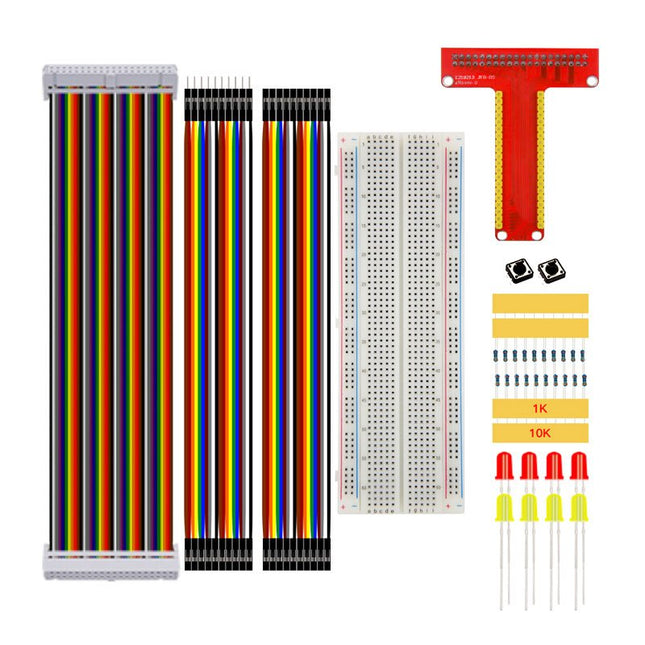
Kuongshun Raspberry Pi T-Type Kit
Features Suitable for Raspberry Pi + GPIO Extension Board Exquisite appearance DIY operation Specifications Size of GPIO Extension Board: 7.5 x 6 cm (3 x 2.4') Size of Breadboard: 16.5 x 5.5 x 1 cm (6.5 x 2.2 x 0.4') Included 1x GPIO Extension Board 1x Breadboard 1x 40P Pin Connect Line 8x 1K Resistor 8x 10K Resistor 4x LED (yellow) 4x LED (red) 4x Key 10x 25 mm Jumper Wires A 10x 25 mm Jumper Wires B
€ 14,95€ 9,95
Members identical
-
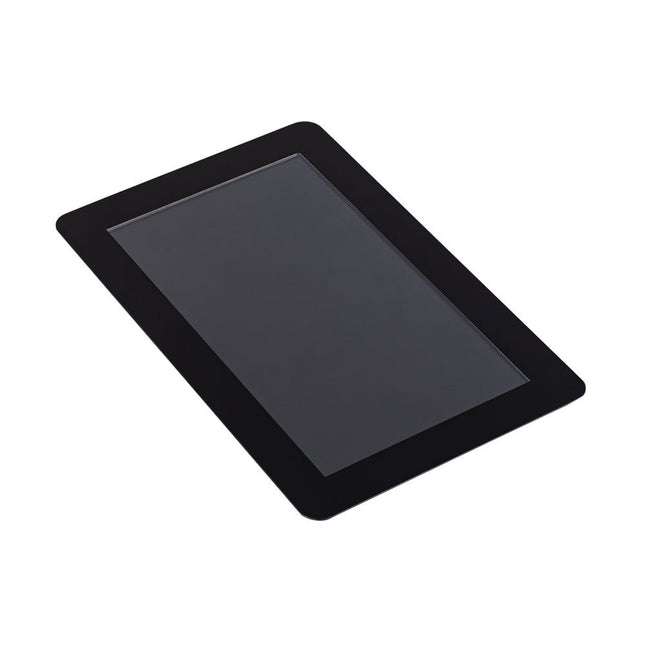
Raspberry Pi Foundation Raspberry Pi Touch Display 2
The Raspberry Pi Touch Display 2 is a 7-inch touchscreen designed for Raspberry Pi, perfect for interactive projects like tablets, entertainment systems, and information dashboards. Raspberry Pi OS includes touchscreen drivers that support five-finger touch and an on-screen keyboard, allowing complete functionality without a physical keyboard or mouse. Connecting the 720 x 1280 display to your Raspberry Pi requires just two connections: power from the GPIO port and a ribbon cable to the DSI port, compatible with all Raspberry Pi models except the Raspberry Pi Zero line. Specifications Display 7 inch TFT (720 x 1280 pixels) Active area 88 x 155 mm Touch panel True multi-touch capacitive touch panel, supporting five-finger touch Surface treatment Anti-glare Color configuration RGB-stripe Backlight type LED B/L Included 1x Raspberry Pi Touch Display 2 1x 22-way to 15-way FFC for Raspberry Pi 5 1x 15-way to 15-way FFC for Raspberry Pi 4 and older 1x GPIO connector cable 8x M2.5 screws Downloads Datasheet
-

Raspberry Pi Foundation Raspberry Pi USB 3.0 Hub
The Raspberry Pi USB 3 Hub expands your device connectivity by converting a single USB-A port into four USB 3.0 ports. With an optional external USB-C power input, it can support high-power peripherals, while lower-power peripherals work without additional power. The USB 3 Hub is fully tested for seamless compatibility with all Raspberry Pi products. Features Single Upstream Connection: USB 3.0 Type-A connector with an 8 cm captive cable Four Downstream Ports: USB 3.0 Type-A ports for multiple device connections High-Speed Data Transfer: Supports speeds up to 5 Gbps Compatibility: Works with USB 3.0 Type-A host ports and is backward-compatible with USB 2.0 ports Downloads Datasheet
-
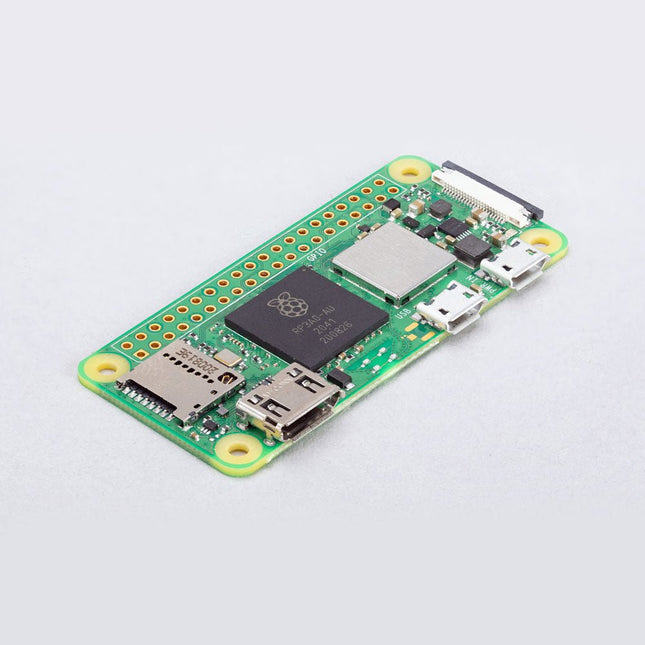
Raspberry Pi Foundation Raspberry Pi Zero 2 W
Raspberry Pi Zero 2 W is the successor to the breakthrough Raspberry Pi Zero W. The board incorporates a quad-core 64-bit Arm Cortex-A53 CPU, clocked at 1 GHz. At its heart is a Raspberry Pi RP3A0 system-in-package (SiP), integrating a Broadcom BCM2710A1 die with 512 MB of LPDDR2 SDRAM. The upgraded processor provides Raspberry Pi Zero 2 W with 40% more single-threaded performance, and five times more multi-threaded performance, than the original single-core Raspberry Pi Zero. Features 64-bit quad-core processor VideoCore IV GPU 512 MB LPDDR2 DRAM 802.11b/g/n wireless LAN Bluetooth 4.2 / Bluetooth Low Energy (BLE) MicroSD card slot Mini HDMI and USB 2.0 OTG ports Micro USB power HAT-compatible 40-pin header Composite video and reset pins via solder test points CSI camera connector Specifications SoC Broadcom BCM2710A1 CPU 64-bit ARM Cortex-A53 (4x 1 GHz) GPU Broadcom VideoCore VI RAM 512 MB LPDDR2 Wireless LAN 2.4 GHz IEEE 802.11b/g/n Bluetooth Bluetooth 4.2, BLE USB 1x micro USB (for data)1x micro USB (for power supply) GPIO HAT-compatible 40-pin GPIO header Video & Audio 1080P HD video & stereo audio via mini-HDMI connector SD card microSD (for operating system and storage) Power 5 VDC / 2.5 A (supplied via micro USB connector) Dimensions 65 x 30 x 5 mm Raspberry Pi Zero 2 W is footprint-compatible with earlier Zero models.
-
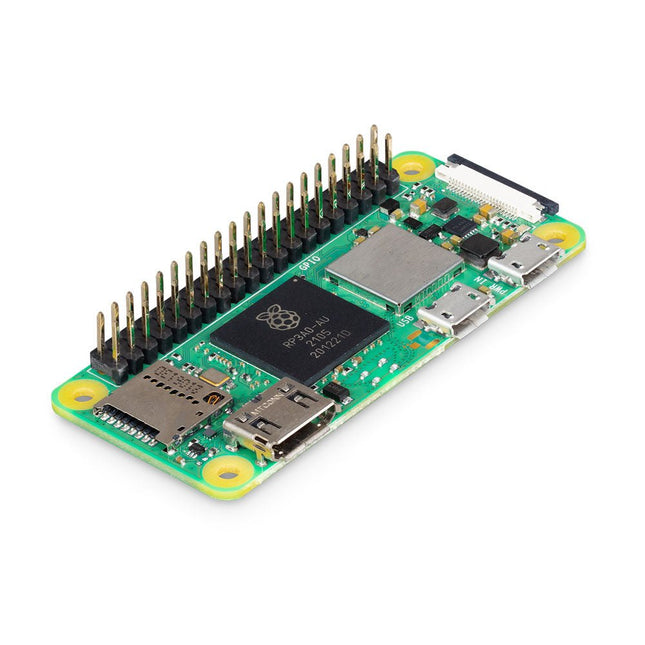
Raspberry Pi Foundation Raspberry Pi Zero 2 WH (with Header)
Raspberry Pi Zero 2 WH is the successor to the breakthrough Raspberry Pi Zero W(H). The board incorporates a quad-core 64-bit Arm Cortex-A53 CPU, clocked at 1 GHz. At its heart is a Raspberry Pi RP3A0 system-in-package (SiP), integrating a Broadcom BCM2710A1 die with 512 MB of LPDDR2 SDRAM. The upgraded processor provides Raspberry Pi Zero 2 WH with 40% more single-threaded performance, and five times more multi-threaded performance, than the original single-core Raspberry Pi Zero. Features 64-bit quad-core processor VideoCore IV GPU 512 MB LPDDR2 DRAM 802.11b/g/n wireless LAN Bluetooth 4.2 / Bluetooth Low Energy (BLE) MicroSD card slot Mini HDMI and USB 2.0 OTG ports Micro USB power With mounted 40-pin header Composite video and reset pins via solder test points CSI camera connector Specifications SoC Broadcom BCM2710A1 CPU 64-bit ARM Cortex-A53 (4x 1 GHz) GPU Broadcom VideoCore VI RAM 512 MB LPDDR2 Wireless LAN 2.4 GHz IEEE 802.11b/g/n Bluetooth Bluetooth 4.2, BLE USB 1x micro USB (for data)1x micro USB (for power supply) GPIO HAT-compatible 40-pin GPIO header Video & Audio 1080P HD video & stereo audio via mini-HDMI connector SD card microSD (for operating system and storage) Power 5 VDC / 2.5 A (supplied via micro USB connector) Dimensions 65 x 30 x 5 mm Raspberry Pi Zero 2 WH is footprint-compatible with earlier Zero models.
-
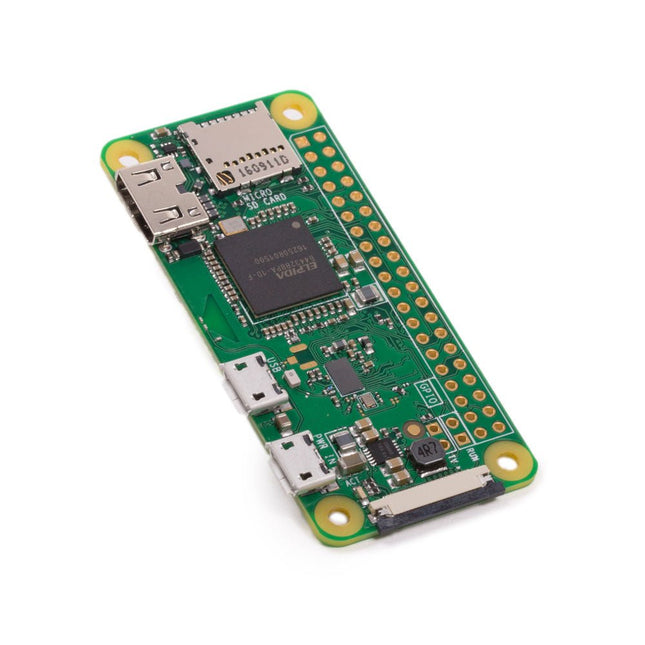
Raspberry Pi Foundation Raspberry Pi Zero W
The Raspberry Pi Zero W extends the Raspberry Pi Zero family. The Raspberry Pi Zero W has all the functionality of the original Raspberry Pi Zero, but comes with added connectivity consisting of: 802.11 b/g/n wireless LAN Bluetooth 4.1 Bluetooth Low Energy (BLE) Other Features 1 GHz, single-core CPU 512 MB RAM Mini HDMI and USB On-The-Go ports Micro-USB power HAT-compatible 40-pin header Composite video and reset headers CSI camera connector Downloads Mechanical Drawing Schematics
-

Elecrow RC070S 7" IPS Capacitive HD Touch Display (1024x600)
This mini IPS 7-inch HD monitor supports a resolution of 1024x600. IPS monitors help keep colors consistent at a wide viewing angle. The 2 removable speakers enhance your audio-visual experiences. Features Four corner holes let you mount the small monitor onto your DIY IoT projects that you’re working on. This Raspberry Pi display also comes with 2 stands, is easy to install and remove, great for on-the-go use. With a capacitive USB touchscreen, simply power the USB touch port to achieve touch function and no need to install the driver, just plug and play! Signal via HDMI-compatible port, power&touch via micro USB port, drive free. No cable solution to Raspberry Pi 4, just using 2 simple adapters to connect your Raspberry Pi 4 directly. You can use it with your Raspberry Pi 4/3/2, Laptop, TV, video game console like Nintendo Switch/Xbox/PS4, and security camera. 170-degree wide view angle 5-point capacitive HD touch display Specifications Display size 7 inch (154 x 86 mm) Resolution 1024 x 600 Display type IPS Touch Capacitive Touchscreen Frame rate 60 fps Brightness 260 cd/m² Speaker Support Interface HD & USB Working temperature −20 to +60°C Dimensions 164 x 99 mm Weight 235 g Included 1x 7-inch Monitor 1x USB to Micro USB Connector 1x HD to Micro HD Connector 1x USB to Micro USB Cable 1x HD to HD Cable 4x M2.5 Screws 4x Small Copper Pillars 2x Pro Stand 2x M3 Screws 2x Speakers 1x User Manual Downloads User Manual
-
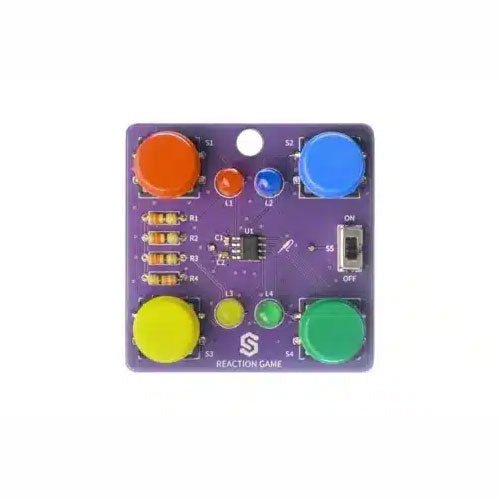
Soldered Reaction Game Solder Kit
If you are looking for a simple way to learn soldering, or just want to make a small gadget that you can carry, this set is a great opportunity. Reaction game is an educational kit which teaches you how to solder, and in the end, you get to have your own small game. The goal of the game is to press the button next to the LED as soon as it turns on. With every correct answer, the game gets a bit harder – the time you have to press the button shortens. How many correct answers can you get? It’s based on ATtiny404 microcontroller, programmed in Arduino. At its back, you’ll find CR2032 battery which makes the kit portable. There’s keychain holder as well. Soldering process is easy enough based on the mark on the PCB. Included 1x PCB 1x ATtiny404 microcontroller 4x LEDs 4x Pushbuttons 1x Switch 4x Resistors (330 ohm) 1x CR2032 battery holder 1x Battery CR2032 1x Keychain holder
€ 9,95
Members € 8,96
-

Seeed Studio reComputer Case for Raspberry Pi, BeagleBone and Jetson Nano
The reComputer case is specially designed for the reComputer system, compatible with all popular SBCs (Raspberry Pi, BeagleBone, and Jetson Nano), with a removable acrylic cover on the top, and with a stackable structure to extend endless possibilities. Features It is compatible with the most popular SBCs including Raspberry Pi, BeagleBone and Jetson Nano. Removable top layer Acrylic Stackable case structure for expansions Included 1x Acrylic Cover 1x Aluminium Frame 1x Heat Dissipation Base 8x Side Panel 8x Standoff 12x Screws 1x Screwdriver 1x Button 1x Assembly Manual Downloads Documentation
-

Seeed Studio reComputer J1020 v2 – Edge AI Device with NVIDIA Jetson Nano (4 GB)
The reComputer J1020 v2 is a compact edge AI device powered by the NVIDIA Jetson Nano 4 GB production module, delivering 0.5 TFLOPs of AI performance. It features a robust aluminum case with a passive heatsink and comes pre-installed with JetPack 4.6.1. The device includes 16 GB of onboard eMMC storage and offers 2x SCI, 4x USB 3.0, M.2 Key M, HDMI, and DP. Applications Computer Vision Machine Learning Autonomous Mobile Robot (AMR) Specifications Jetson Nano 4 GB System-on-Module AI Performance Jetson Nano 4 GB (0.5 TOPS) GPU NVIDIA Maxwel architecture with 128 NVIDIA CUDA cores CPU Quad-core ARM Cortex-A57 MPCore processor Memory 4 GB 64-bit LPDDR4 25.6 GB/s Video Encoder 1x 4K30 | 2x 1080p60 | 4x 1080p30 | 4x 720p60 | 9x 720p30 (H.265 & H.264) Video Decoder 1x 4K60 | 2x 4K30 | 4x 1080p60 | 8x 1080p30 | 9x 720p60 (H.265 & H.264) Carrier Board Storage 1x M.2 Key M PCIe Networking Ethernet 1x RJ-45 Gigabit Ethernet (10/100/1000M) I/O USB 4x USB 3.0 Type-A1x Micro-USB port for device mode CSI Camera 2x CSI (2-lane 15-pin) Display 1x HDMI Type A; 1x DP Fan 1x 4-pin Fan Connector (5 V PWM) CAN 1x CAN Multifunctional Port 1x 40-Pin Expansion header 1x 12-Pin Control and UART header Power Supply DC 12 V/2 A Mechanical Dimensions 130 x 120 x 50 mm (with Case) Installation Desktop, wall-mounting Operating Temperature −10°C~60°C Included reComputer J1020 v2 (system installed) 12 V/2 A power adapter (with 5 interchangeable adapter plugs) Downloads reComputer J1020 v2 datasheet reComputer J1020 v2 3D file Seeed NVIDIA Jetson Product Catalog NVIDIA Jetson Device and Carrier Boards Comparison
€ 369,00€ 184,50
Members identical
-

Seeed Studio reComputer J3010 – Edge AI Device with NVIDIA Jetson Orin Nano (4 GB)
The reComputer J3010 is a compact and powerful edge AI device powered by the NVIDIA Jetson Orin Nano SoM, delivering an impressive 20 TOPS AI performance – up to 40 times faster than the Jetson Nano. Pre-installed with Jetpack 5.1.1, it features a 128 GB SSD, 4x USB 3.2 ports, HDMI, Gigabit Ethernet, and a versatile carrier board with M.2 Key E for WiFi, M.2 Key M for SSD, RTC, CAN, and a 40-pin GPIO header. Applications AI Video Analytics Machine Vision Robotics Specifications Jetson Orin Nano System-on-Module AI Performance reComputer J3010, Orin Nano 4 GB (20 TOPS) GPU 512-core NVIDIA Ampere architecture GPU with 16 Tensor Cores (Orin Nano 4 GB) CPU 6-core Arm Cortex-A78AE v8.2 64-bit CPU 1.5 MB L2 + 4 MB L3 Memory 4 GB 64-bit LPDDR5 34 GB/s (Orin Nano 4 GB) Video Encoder 1080p30 supported by 1-2 CPU cores Video Decoder 1x 4K60 (H.265) | 2x 4K30 (H.265) | 5x 1080p60 (H.265) | 11x 1080p30 (H.265) Carrier Board Storage M.2 Key M PCIe (M.2 NVMe 2280 SSD 128 GB included) Networking Ethernet 1x RJ-45 Gigabit Ethernet (10/100/1000M) M.2 Key E 1x M.2 Key E (pre-installed 1x Wi-Fi/Bluetooth combo module) I/O USB 4x USB 3.2 Type-A (10 Gbps)1x USB 2.0 Type-C (Device Mode) CSI Camera 2x CSI (2-lane 15-pin) Display 1x HDMI 2.1 Fan 1x 4-pin Fan Connector (5 V PWM) CAN 1x CAN Multifunctional Port 1x 40-Pin Expansion header 1x 12-Pin Control and UART header RTC RTC 2-pin, supports CR1220 (not included) Power Supply 9-19 V DC Mechanical Dimensions 130 x 120 x 58.5 mm (with Case) Installation Desktop, wall-mounting Operating Temperature −10°C~60°C Included 1x reComputer J3010 (system installed) 1x Power adapter (12 V / 5 A) Downloads reComputer J301x Datasheet NVIDIA Jetson Devices and carrier boards comparisions reComputer J401 schematic design file reComputer J3010 3D file
€ 699,00€ 349,00
Members identical
-
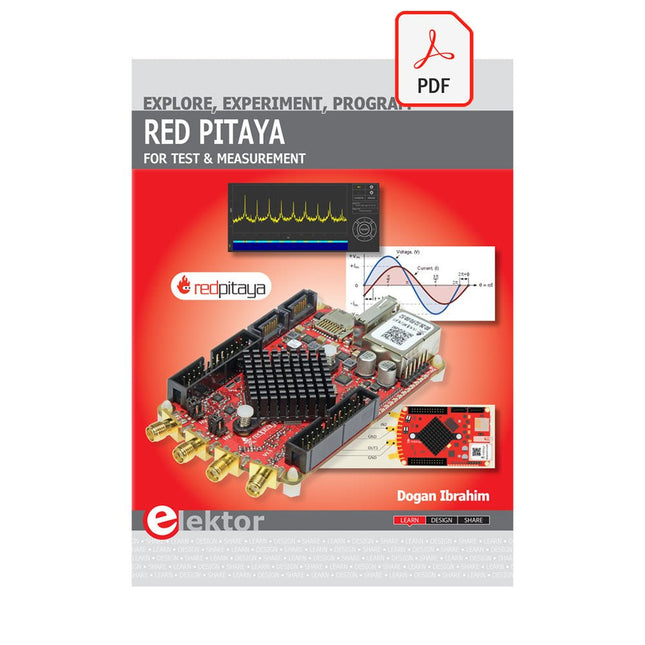
Elektor Digital Red Pitaya for Test and Measurement (E-book)
The Red Pitaya (STEMlab) is a credit card-sized, open-source test and measurement board that can be used to replace most measurement instruments used in electronics laboratories. With a single click, the board can transform into a web-based oscilloscope, spectrum analyser, signal generator, LCR meter, Bode plotter, and microcontroller. The Red Pitaya (STEMlab) can replace the many pieces of expensive measurement equipment found at professional research organisations and teaching laboratories. The device, that based on Linux, includes an FPGA, digital signal processing (DSP), dual core ARM Cortex processor, signal acquisition and generation circuitry, micro USB socket, microSD card slot, RJ45 socket for Ethernet connection, and USB socket – all powered from an external mains adaptor. This book is an introduction to electronics. It aims to teach the principles and applications of basic electronics by carrying out real experiments using the Red Pitaya (STEMlab). The book includes many chapters on basic electronics and teaches the theory and use of electronic components including resistors, capacitors, inductors, diodes, transistors, and operational amplifiers in electronic circuits. Many fun and interesting Red Pitaya (STEMlab) experiments are included in the book. The book also makes an introduction to visual programming environment. The book is written for college level and first year university students studying electrical or electronic engineering.
€ 29,95
Members € 23,96
-

Elektor Publishing Renewable Energy at Home
A Hands-on Guide to Crafting Your Own Power Plant The book you are about to read provides a step-by-step guide for building a renewable energy power plant at home. Our goal was to make the book as practical as possible. The material is intended for immediate application with a small amount of theory. Yet, the theory is important as a foundation that saves time and effort by disabusing the readers of potential misconceptions. Specifically, upon having a firm understanding of photovoltaic physics, you will not be inclined to fruitlessly search for 90% efficient solar panels! We want our readers to be the “doers”. If the book gets covered in grime and some pages become torn while you are building your power plant – this is the best compliment to us. The book covers solar and wind energy. Also, a curious power source based on manure is discussed as well, giving the doers an opportunity to further develop the manure fuel cell. It is important to note that there are many companies offering installation of complete solar solutions. Upon installing the panels, the system is not owned by the customer. Therefore, there is no freedom for experimentation and optimization. Also, none can beat the cost of a DIY solution as well as the ultimate satisfaction. All that is written here is a result of us building a renewable energy solution in Southern California. As the book was completed, the energy began flowing!
€ 29,95
Members € 26,96
-

Elektor Digital Renewable Energy at Home (E-book)
A Hands-on Guide to Crafting Your Own Power Plant The book you are about to read provides a step-by-step guide for building a renewable energy power plant at home. Our goal was to make the book as practical as possible. The material is intended for immediate application with a small amount of theory. Yet, the theory is important as a foundation that saves time and effort by disabusing the readers of potential misconceptions. Specifically, upon having a firm understanding of photovoltaic physics, you will not be inclined to fruitlessly search for 90% efficient solar panels! We want our readers to be the “doers”. If the book gets covered in grime and some pages become torn while you are building your power plant – this is the best compliment to us. The book covers solar and wind energy. Also, a curious power source based on manure is discussed as well, giving the doers an opportunity to further develop the manure fuel cell. It is important to note that there are many companies offering installation of complete solar solutions. Upon installing the panels, the system is not owned by the customer. Therefore, there is no freedom for experimentation and optimization. Also, none can beat the cost of a DIY solution as well as the ultimate satisfaction. All that is written here is a result of us building a renewable energy solution in Southern California. As the book was completed, the energy began flowing!
€ 24,95
Members € 19,96
-
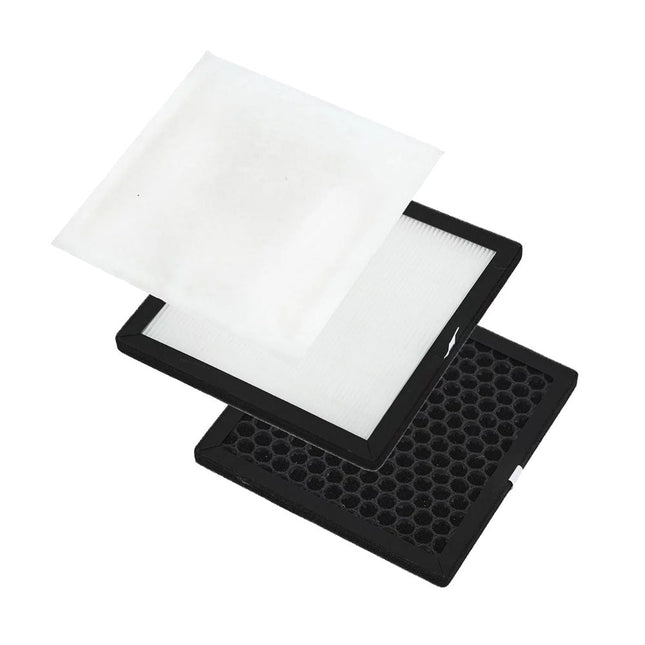
Aoyue Replacement Filter Set for Aoyue 8486 Fume Extractor
This complete replacement filter set for the Aoyue 8486 Fume Extractor contains a HEPA (High Efficiency Particulate Air) filter, a cotton air (sub) filter and an activated carbon air filter.
€ 39,95
Members € 35,96
-

Evil Mad Science Replacement Servo Motor for AxiDraw
The only expendable component of the AxiDraw is the small, blue pen-lift servo motor. They do wear out over time but are straightforward to replace. For heavy duty applications, you may wish to keep a spare on hand. This replacement servo motor has been calibrated to the correct range, has the extended servo horn attached, and is ready to install. Includes a few cable ties to keep things neat. Compatible with: AxiDraw V3 AxiDraw V3/A3 AxiDraw SE/A3 AxiDraw V3 XLX Custom assembled AxiDraw models
-

Elektor Digital Retro Audio (E-book)
The intention of this book is to offer the reader understandings, ideas and solutions from the perspective of a workbench technician and electronics hobbyist. It is a descriptive text with many tables of useful data, servicing tips and supplementary notes of not so common knowledge. Today there is a re-emerging, nostalgic interest in vinyl records and associated music entertainment gear. With this interest, there is a paralleled market for the repair of this gear. This ‘hands-on’ servicing guide opens with fundamental considerations of the work space of repair and servicing. This includes a comprehensive discussion of essential test equipment and tools. Two chapters are devoted to obtaining servicing information about repair and obtaining spare parts. A key chapter is on general diagnosis and testing and includes the discussion of resistance, capacitance and inductance. These electrical properties are regularly in the mind of the repairer, so understanding of them is a key objective of this book. The next chapter is about time saving repair techniques and ensuring quality repair. The remaining chapters discuss entertainment equipment itself. Each of the chapters begins with an orderly discussion of the theory of operation and common and not so common problems specific to the equipment. All chapters conclude with a summary.
€ 24,95
Members € 19,96
-

Elektor Digital Retronics (E-book)
Quite unintentionally a one-page story on an old Heathkit tube tester in the December 2004 edition of Elektor magazine spawned dozens of ‘Retronics’ tales appearing with a monthly cadence, and attracting a steady flow of reader feedback and contributions to the series. Since launching his Retronics columns, Elektor Editor Jan Buiting has never been short of copy to print, or vintage equipment to marvel at. This book is a compilation of about 80 Retronics installments published between 2004 and 2012. The stories cover vintage test equipment, prehistoric computers, long forgotten components, and Elektor blockbuster projects, all aiming to make engineers smile, sit up, object, drool, or experience a whiff of nostalgia. To reflect that our memories are constantly playing tricks on us, and honoring that “one man’s rubbish is another man’s gem”, the tales in the book purposely have no chronological order, and no bias in favor of transistor or tube, microprocessor or discrete part, audio or RF, DIY or professional, dry or narrative style. Although vastly diff erent in subject matter, all tales in the book are told with personal gusto because Retronics is about sentiment in electronics engineering, construction and repair, be it to reminisce about a 1960s Tektronix scope with a cleaning lady as a feature, or a 1928 PanSanitor box for dubious medical use. Owners of this book are advised to not exceed one Retronics tale per working day, preferably consumed in the evening hours under lamp light, in a comfortable chair, with a piece of vintage electronic equipment close and powered up.
€ 24,95
Members € 19,96
-

Farnell element14 RF/Coaxial Cable Assembly – SMA Plug to SMA Plug (76.2 mm) MC001054
SMA Straight Plug to SMA Straight Plug, 76.2 mm Specifications Frequency range 0 to 18 GHz VSWR (≤1.35) Insertion loss ≤0,22 db Body Brass Nickel Centre contact Brass Gold Insulator PTFE
€ 14,95
Members € 13,46
-

Elektor Digital RFID (E-book)
RFID technology has conquered many areas in which barcodes, magnetic strips and contact smartcards were used previously. Everyday applications, such as electronic ticketing, access cards, debit cards and electronic identity documents would not be possible without this technology. MIFARE is the most widely used RFID technology, and this book provides a practical and comprehensive introduction to it. Among other things, the initial chapters cover physical fundamentals, relevant standards, RFID antenna design, security considerations and cryptography. The complete design of a reader’s hardware and software is described in detail. The reader’s firmware and the associated PC software support programming using any .NET language. The specially developed PC program, “Smart Card Magic.NET”, is a simple development environment that supports sending commands to a card at the click of a mouse, as well as the ability to create C# scripts. Alternatively, one may follow all of the examples using Visual Studio 2010 Express Edition. Finally, the major smart card reader API standards are introduced. The focus is on programming contactless smartcards using standard PC/SC readers using C/C++, Java and C#.
€ 34,95
Members € 27,96























